-
 Bitcoin
Bitcoin $105,344.2368
0.31% -
 Ethereum
Ethereum $2,525.1985
-0.34% -
 Tether USDt
Tether USDt $1.0003
-0.01% -
 XRP
XRP $2.1493
-1.09% -
 BNB
BNB $647.4020
-0.50% -
 Solana
Solana $145.4505
-0.13% -
 USDC
USDC $1.0000
0.02% -
 Dogecoin
Dogecoin $0.1751
-0.83% -
 TRON
TRON $0.2715
0.72% -
 Cardano
Cardano $0.6265
-1.42% -
 Hyperliquid
Hyperliquid $40.2768
-4.86% -
 Sui
Sui $2.9832
-1.19% -
 Bitcoin Cash
Bitcoin Cash $439.7471
1.55% -
 Chainlink
Chainlink $13.1277
-0.43% -
 UNUS SED LEO
UNUS SED LEO $9.2522
2.44% -
 Stellar
Stellar $0.2562
-1.31% -
 Avalanche
Avalanche $18.9101
-1.33% -
 Toncoin
Toncoin $2.9590
-1.90% -
 Shiba Inu
Shiba Inu $0.0...01199
-0.94% -
 Hedera
Hedera $0.1535
-3.51% -
 Litecoin
Litecoin $85.3496
-1.32% -
 Polkadot
Polkadot $3.7734
-0.70% -
 Ethena USDe
Ethena USDe $1.0002
-0.03% -
 Monero
Monero $317.9171
0.06% -
 Dai
Dai $0.9999
0.00% -
 Bitget Token
Bitget Token $4.5211
-0.42% -
 Pepe
Pepe $0.0...01112
0.05% -
 Pi
Pi $0.6135
5.52% -
 Uniswap
Uniswap $7.1974
-1.48% -
 Aave
Aave $272.7537
-1.21%
BTC high leverage trading skills: RSI trend line analysis
Use RSI and trend lines to spot BTC trading opportunities: enter long when RSI is oversold and price breaks upward trend line.
Jun 13, 2025 at 11:07 am
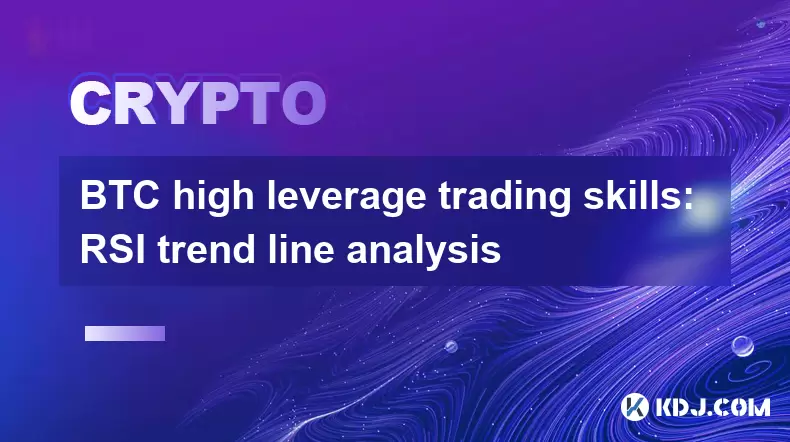
BTC high leverage trading skills: RSI trend line analysis
High leverage trading in Bitcoin (BTC) can be a lucrative yet risky endeavor. Among the many technical analysis tools available to traders, the Relative Strength Index (RSI) and trend line analysis are particularly useful for making informed trading decisions. This article delves into how traders can combine RSI with trend line analysis to enhance their high leverage trading strategies in the BTC market.
Understanding RSI in BTC Trading
The Relative Strength Index (RSI) is a momentum oscillator that measures the speed and change of price movements. In the context of BTC trading, the RSI can help traders identify overbought or oversold conditions. The RSI is typically displayed as an oscillator (a line graph) that moves between zero and 100. Traditionally, an RSI above 70 indicates that an asset might be overbought, while an RSI below 30 suggests it may be oversold.
For high leverage trading, understanding the RSI is crucial because it can signal potential reversals in the market. When trading BTC with high leverage, small price movements can result in significant gains or losses, making it essential to have a reliable tool like the RSI to gauge market conditions.
Trend Line Analysis in BTC Markets
Trend lines are another powerful tool for traders, especially when combined with high leverage trading. A trend line is a straight line that connects two or more price points and extends into the future to act as a line of support or resistance. In the BTC market, trend lines help traders visualize the direction of the market and identify potential breakout or breakdown points.
In high leverage trading, trend lines can be particularly useful for setting entry and exit points. By drawing trend lines on the BTC price chart, traders can better understand the current trend and anticipate where the price might move next. This is essential for managing the risks associated with high leverage trading.
Combining RSI and Trend Line Analysis
Combining RSI with trend line analysis can provide a more robust trading strategy for BTC high leverage traders. Here’s how these two tools can work together:
Identify Overbought/Oversold Conditions with RSI: Use the RSI to spot when BTC might be overbought (above 70) or oversold (below 30). This can help traders anticipate potential reversals.
Confirm Trends with Trend Lines: Draw trend lines on the BTC price chart to confirm the direction of the trend. If the trend line aligns with the RSI readings, it can provide stronger signals for entry or exit points.
Look for Divergence: Pay attention to divergence between the BTC price and the RSI. If the price is making new highs but the RSI is not, it could signal a weakening trend and a potential reversal.
Set Entry and Exit Points: Use the combination of RSI and trend lines to set precise entry and exit points. For example, if the RSI indicates an oversold condition and the price breaks above a trend line, it might be a good entry point for a long position.
Practical Application in High Leverage Trading
To effectively apply RSI and trend line analysis in high leverage BTC trading, traders need to follow a systematic approach. Here’s how to do it:
Select a Trading Platform: Choose a reliable trading platform that offers high leverage options and charting tools. Ensure the platform has the capability to plot RSI and trend lines.
Set Up Your Chart: Open a BTC chart on your chosen platform and add the RSI indicator. Set the RSI period to 14, which is the standard setting.
Draw Trend Lines: Identify key price points on the chart and draw trend lines to connect these points. Look for at least two points to establish a valid trend line.
Monitor RSI Readings: Keep an eye on the RSI readings. If the RSI moves above 70, be cautious of a potential reversal. If it drops below 30, consider it a potential buying opportunity.
Combine Signals: When the RSI indicates an overbought or oversold condition and the price breaks a trend line, it can be a strong signal to enter or exit a trade. For example, if the RSI is below 30 and the price breaks above a downward trend line, it might be a good time to enter a long position.
Set Stop-Loss and Take-Profit Levels: Given the high risk of leverage trading, always set stop-loss and take-profit levels based on the signals from RSI and trend lines. This helps manage risk and protect profits.
Risk Management in High Leverage Trading
Risk management is critical when trading BTC with high leverage. The combination of RSI and trend line analysis can help traders make more informed decisions, but it’s essential to implement sound risk management practices. Here are some key strategies:
Use Stop-Loss Orders: Always set stop-loss orders to limit potential losses. The placement of these orders can be informed by the RSI and trend lines.
Manage Position Size: Given the amplified risks of high leverage trading, manage your position size carefully. Even a small move against your position can result in significant losses.
Monitor Market Conditions: Keep a close eye on broader market conditions and news that might affect BTC prices. High leverage trading requires constant vigilance.
Diversify Your Trades: Don’t put all your capital into a single high leverage trade. Diversify your trades to spread the risk.
Case Study: Applying RSI and Trend Line Analysis
Let’s consider a practical example of how RSI and trend line analysis can be applied in high leverage BTC trading. Suppose BTC has been in a downtrend, and the RSI is showing readings below 30, indicating an oversold condition. At the same time, the price breaks above a downward trend line.
Entry Point: This could be a strong signal to enter a long position. The trader might decide to buy BTC at the breakout point, expecting a reversal.
Stop-Loss: The stop-loss could be set just below the broken trend line to limit potential losses if the price fails to continue upward.
Take-Profit: The take-profit level could be set based on previous resistance levels or a target RSI reading, such as when it reaches 70, indicating an overbought condition.
By following this strategy, the trader can capitalize on the potential reversal signaled by the RSI and trend line analysis while managing the risks associated with high leverage trading.
FAQs
Q1: Can RSI and trend line analysis be used for other cryptocurrencies besides BTC?
A1: Yes, RSI and trend line analysis can be applied to other cryptocurrencies. The principles remain the same, but traders should be aware of the unique volatility and market conditions of each cryptocurrency.
Q2: How often should I check the RSI and trend lines when trading with high leverage?
A2: Given the fast-paced nature of high leverage trading, it’s advisable to monitor the RSI and trend lines frequently, ideally in real-time. This helps traders react quickly to changing market conditions.
Q3: What are the common pitfalls to avoid when using RSI and trend line analysis in high leverage trading?
A3: Common pitfalls include over-reliance on a single indicator, ignoring broader market trends, and failing to set proper stop-loss orders. Traders should use RSI and trend lines as part of a comprehensive trading strategy.
Q4: Is it possible to automate trading strategies based on RSI and trend line analysis?
A4: Yes, it is possible to automate trading strategies using algorithms that incorporate RSI and trend line analysis. However, traders should thoroughly test and monitor such automated systems to ensure they perform well under various market conditions.
Disclaimer:info@kdj.com
The information provided is not trading advice. kdj.com does not assume any responsibility for any investments made based on the information provided in this article. Cryptocurrencies are highly volatile and it is highly recommended that you invest with caution after thorough research!
If you believe that the content used on this website infringes your copyright, please contact us immediately (info@kdj.com) and we will delete it promptly.
- Bitcoin Mining Games Are Changing the Crypto Landscape
- 2025-06-15 16:35:12
- Dogecoin & Other Top Memecoins Have Seen A Spike In Social Dominance
- 2025-06-15 16:35:12
- Will XRP Break Above $10? Here's When the Journey May Begin and Should You Buy the Dip?
- 2025-06-15 16:30:12
- The cryptocurrency realm remains volatile, a high-stakes rollercoaster where fortunes turn in the blink of an eye
- 2025-06-15 16:30:12
- Bitcoin Is Approaching an Important Resistance Level on the Daily Charts
- 2025-06-15 16:25:12
- Worldcoin ($WLD) Is Making a Comeback
- 2025-06-15 16:25:12
Related knowledge
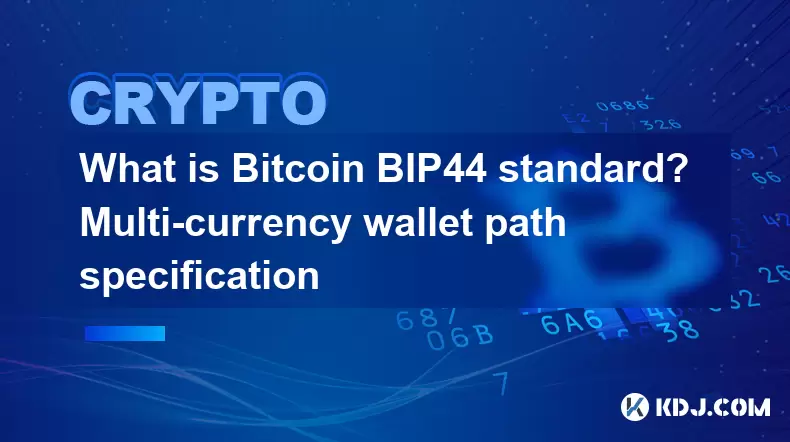
What is Bitcoin BIP44 standard? Multi-currency wallet path specification
Jun 15,2025 at 04:08pm
Understanding the BIP44 Standard in Bitcoin and CryptocurrencyThe BIP44 standard, which stands for Bitcoin Improvement Proposal 44, is a widely adopted hierarchical deterministic wallet structure used across various cryptocurrencies. It defines a structured path format that enables wallets to support multiple currencies while maintaining consistency and...
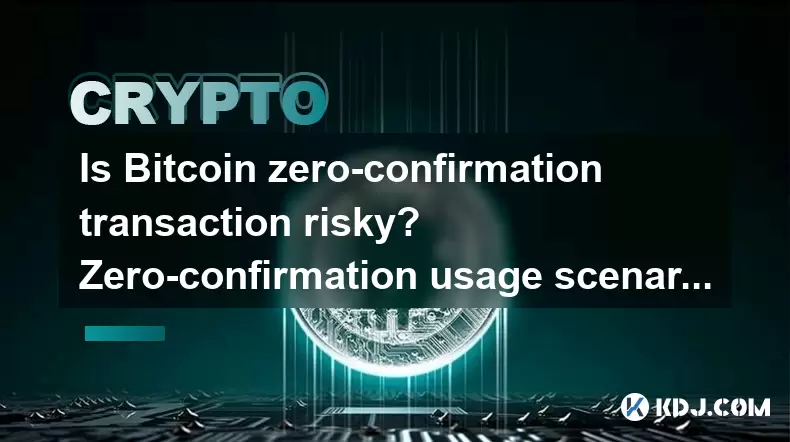
Is Bitcoin zero-confirmation transaction risky? Zero-confirmation usage scenarios
Jun 15,2025 at 03:57am
Understanding Zero-Confirmation Transactions in BitcoinBitcoin zero-confirmation transactions, often referred to as 'unconfirmed transactions,' are those that have been broadcast to the network but have not yet been included in a block. This means they have not received any confirmations from miners. While these transactions can be useful in certain con...
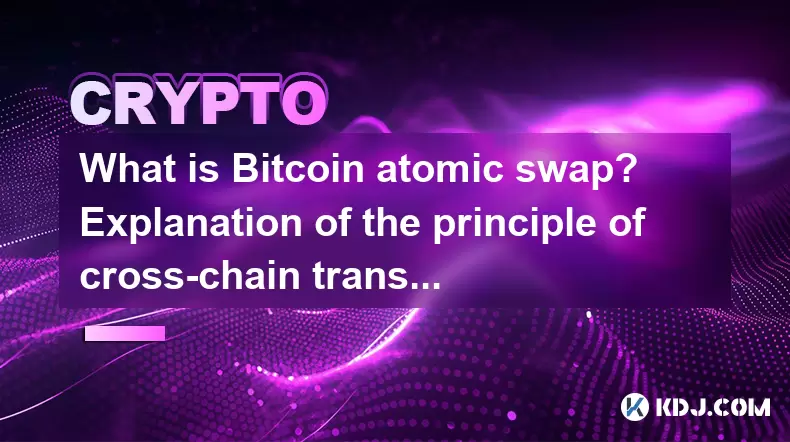
What is Bitcoin atomic swap? Explanation of the principle of cross-chain transactions
Jun 15,2025 at 03:49pm
Understanding Bitcoin Atomic SwapsBitcoin atomic swaps refer to a peer-to-peer exchange mechanism that enables the direct swapping of cryptocurrencies across different blockchains without relying on centralized exchanges or third-party intermediaries. This technology is especially relevant for users who wish to trade Bitcoin (BTC) with other blockchain-...
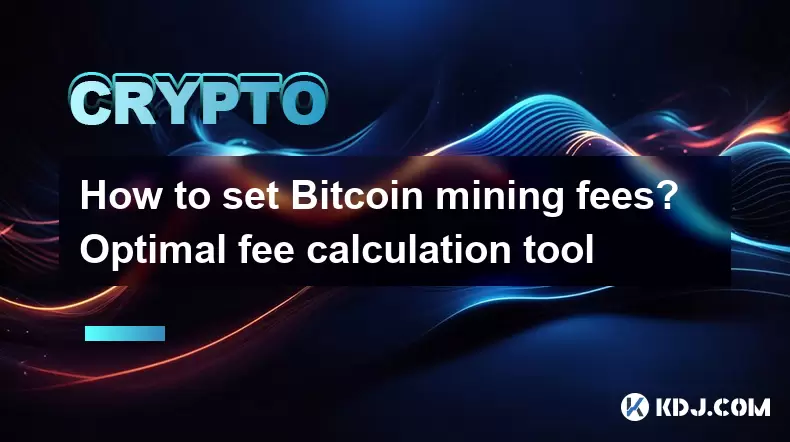
How to set Bitcoin mining fees? Optimal fee calculation tool
Jun 15,2025 at 09:49am
Understanding Bitcoin Mining FeesBitcoin mining fees, also known as transaction fees, are the amounts paid by users to have their transactions included in a block by miners. These fees are not fixed and fluctuate based on network congestion and priority settings. The higher the fee, the faster your transaction will be confirmed because miners prioritize...

What to do with unconfirmed Bitcoin transactions? Summary of accelerated confirmation methods
Jun 14,2025 at 01:21am
Understanding Unconfirmed Bitcoin TransactionsWhen a Bitcoin transaction is broadcast to the network but has not yet been included in a block, it is referred to as an unconfirmed transaction. This typically happens due to network congestion or low transaction fees. While unconfirmed transactions are not finalized, they remain in the mempool, waiting for...
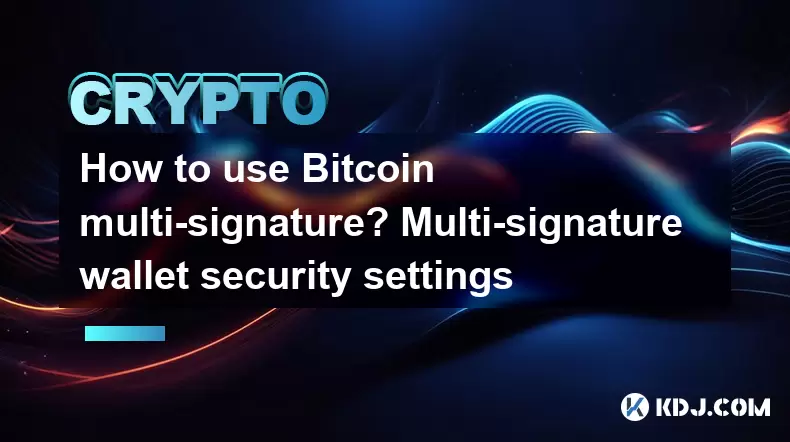
How to use Bitcoin multi-signature? Multi-signature wallet security settings
Jun 15,2025 at 12:14am
What is Bitcoin Multi-Signature?Bitcoin multi-signature (or multisig) refers to a type of digital signature that allows multiple parties to sign a transaction. Unlike traditional single-signature wallets, where only one private key is needed to authorize a transfer, multi-signature wallets require more than one private key to complete a transaction. Thi...

What is Bitcoin BIP44 standard? Multi-currency wallet path specification
Jun 15,2025 at 04:08pm
Understanding the BIP44 Standard in Bitcoin and CryptocurrencyThe BIP44 standard, which stands for Bitcoin Improvement Proposal 44, is a widely adopted hierarchical deterministic wallet structure used across various cryptocurrencies. It defines a structured path format that enables wallets to support multiple currencies while maintaining consistency and...

Is Bitcoin zero-confirmation transaction risky? Zero-confirmation usage scenarios
Jun 15,2025 at 03:57am
Understanding Zero-Confirmation Transactions in BitcoinBitcoin zero-confirmation transactions, often referred to as 'unconfirmed transactions,' are those that have been broadcast to the network but have not yet been included in a block. This means they have not received any confirmations from miners. While these transactions can be useful in certain con...

What is Bitcoin atomic swap? Explanation of the principle of cross-chain transactions
Jun 15,2025 at 03:49pm
Understanding Bitcoin Atomic SwapsBitcoin atomic swaps refer to a peer-to-peer exchange mechanism that enables the direct swapping of cryptocurrencies across different blockchains without relying on centralized exchanges or third-party intermediaries. This technology is especially relevant for users who wish to trade Bitcoin (BTC) with other blockchain-...

How to set Bitcoin mining fees? Optimal fee calculation tool
Jun 15,2025 at 09:49am
Understanding Bitcoin Mining FeesBitcoin mining fees, also known as transaction fees, are the amounts paid by users to have their transactions included in a block by miners. These fees are not fixed and fluctuate based on network congestion and priority settings. The higher the fee, the faster your transaction will be confirmed because miners prioritize...

What to do with unconfirmed Bitcoin transactions? Summary of accelerated confirmation methods
Jun 14,2025 at 01:21am
Understanding Unconfirmed Bitcoin TransactionsWhen a Bitcoin transaction is broadcast to the network but has not yet been included in a block, it is referred to as an unconfirmed transaction. This typically happens due to network congestion or low transaction fees. While unconfirmed transactions are not finalized, they remain in the mempool, waiting for...

How to use Bitcoin multi-signature? Multi-signature wallet security settings
Jun 15,2025 at 12:14am
What is Bitcoin Multi-Signature?Bitcoin multi-signature (or multisig) refers to a type of digital signature that allows multiple parties to sign a transaction. Unlike traditional single-signature wallets, where only one private key is needed to authorize a transfer, multi-signature wallets require more than one private key to complete a transaction. Thi...
See all articles

























































































